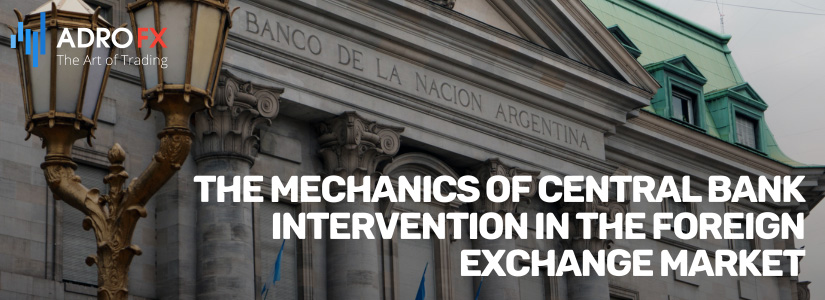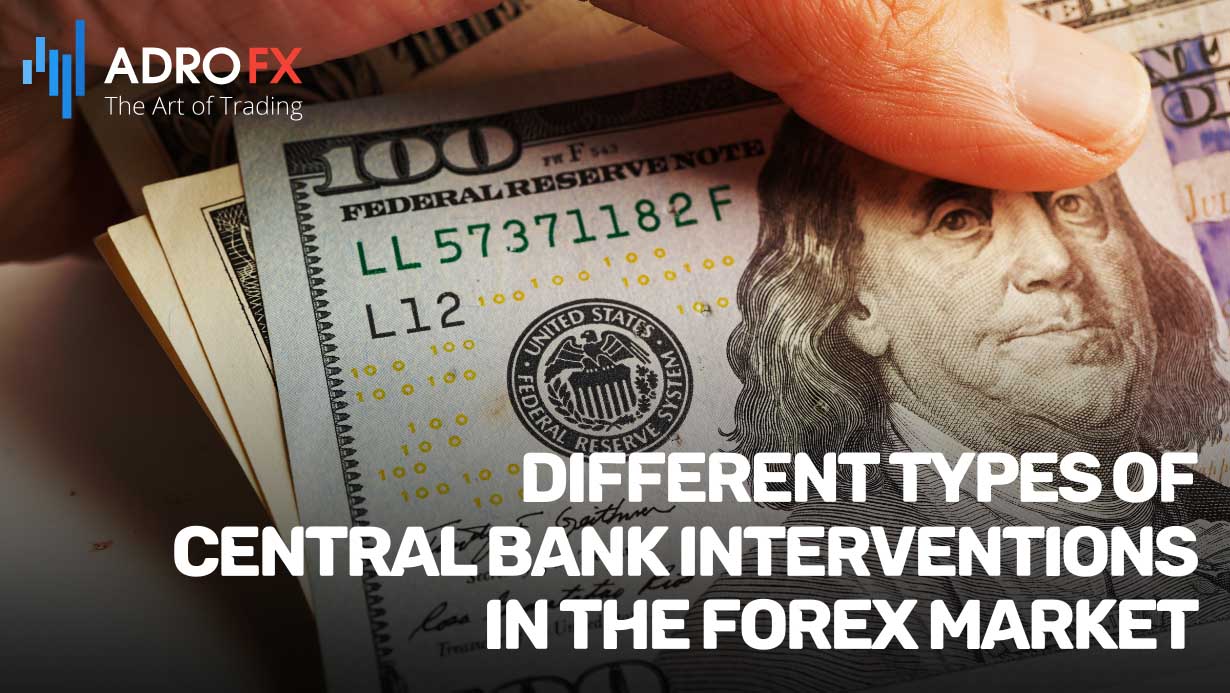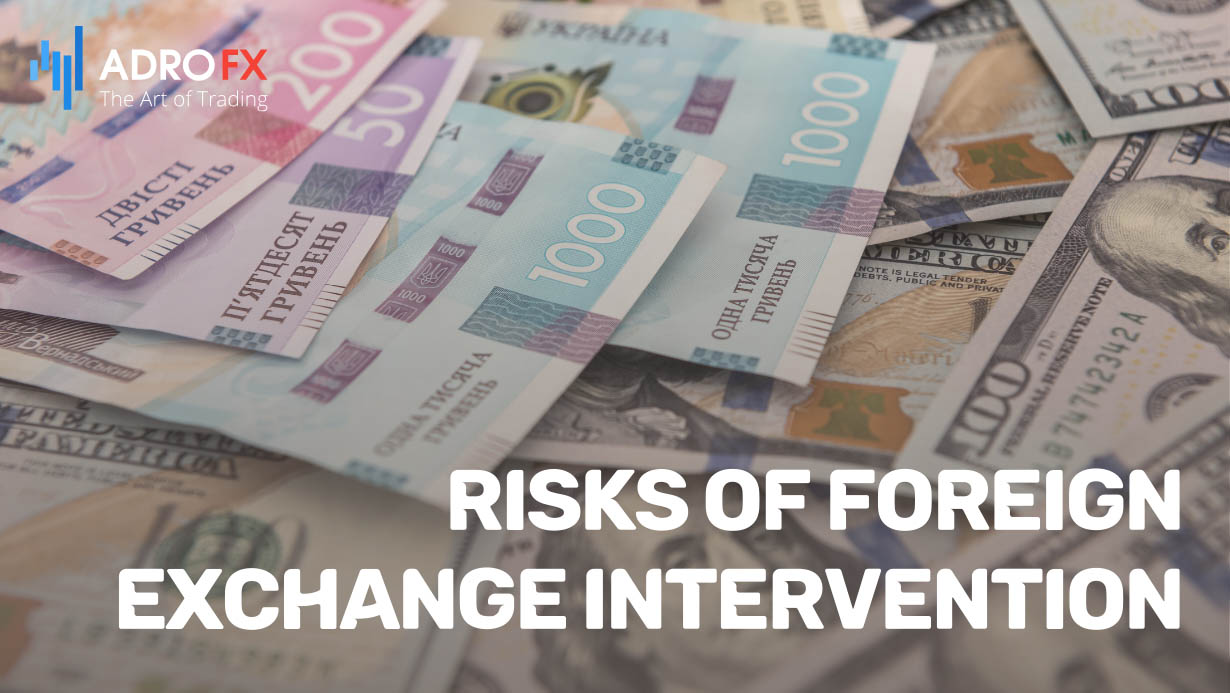The Mechanics of Central Bank Intervention in the Foreign Exchange Market

Central Banks seldom make their presence felt in the forex market, and when they do, it often suggests significant economic vulnerabilities within a currency. Typically, central bank interventions are prompted by crises, whether it's an authentic economic downturn akin to the 2008 crisis or the Euro crisis, or a scenario where a currency faces the brunt of speculative attacks.
The interventions themselves take on various forms, each differing in commitment levels and effectiveness. In this exploration, we delve into the intricacies of four noteworthy types of central bank interventions. By understanding these strategies, we gain insight into how central banks respond to economic challenges and navigate the complexities of speculative pressures in the forex market.
What Are Central Bank Interventions and Why Intervene?
Central bank interventions in the foreign exchange market refer to the actions taken by a country's central bank to influence the value of its currency relative to other currencies. Central banks intervene in the forex market to achieve various economic and monetary policy objectives. Here are some common forms of central bank interventions:
- Currency Stabilization
Central banks intervene to stabilize their currency's exchange rate. If a currency is depreciating rapidly, a central bank may buy its own currency in the forex market to increase demand and, consequently, its value. - Export Competitiveness
Central banks may intervene to maintain or enhance the competitiveness of their country's exports. If a currency becomes too strong, it can make exports more expensive and less competitive in international markets. In such cases, a central bank may sell its currency to weaken it and make exports more attractive. - Inflation Control
Central banks may intervene to control inflation. A weaker currency can contribute to higher inflation by increasing the cost of imported goods. To counter this, a central bank may intervene to strengthen its currency. - Market Confidence
Central banks may intervene to restore or maintain market confidence during periods of extreme volatility. Sudden and sharp movements in exchange rates can lead to disruptions in financial markets, and central banks may step in to provide stability. - Reserve Management
Central banks often hold significant foreign exchange reserves. They may intervene in the forex market to manage these reserves efficiently, ensuring liquidity and diversification. - Financial Stability
Central banks may intervene to address financial stability concerns. For example, if a rapid depreciation of the domestic currency threatens the stability of the banking system, a central bank may intervene to stabilize the currency. - Speculative Attacks
In some cases, central banks may intervene to counter speculative attacks on their currency. Speculators may try to force a currency devaluation, and central banks may respond by buying their own currency to counteract the pressure.
Central bank interventions can take the form of buying or selling currencies in the open market, adjusting interest rates, implementing capital controls, or using other policy tools. It's important to note that while interventions can have short-term effects on exchange rates, sustained and long-term currency value is influenced by a variety of economic factors, including interest rates, inflation, trade balances, and overall economic performance.

Different Types of Central Bank Interventions in the Forex Market
Central banks use various types of interventions to influence the foreign exchange market and achieve specific economic and monetary policy objectives. Here are some common types of central bank interventions:
Jawboning
Jawboning is a strategic communication technique employed by сentral banks to manage forex reserves. Instead of immediate action, сentral banks use rhetoric to convey their target currency levels. By openly discussing the possibility of intervention if a currency exceeds a specified threshold, central banks influence market participants. Traders, cognizant of the central banks' financial clout, often align their trading within the declared range without the need for direct intervention. Jawboning acts as a preemptive measure, resetting rates through the mere threat of intervention, particularly effective when central banks have a history of periodic market interventions.
Operational Intervention
This method involves direct action by central banks in the forex market. Here, central banks actively buy or sell currencies to achieve their desired exchange rates. Unlike traders seeking earnings, central banks are willing to endure losses to meet their objectives. However, operational intervention poses a risk to a central bank's forex reserves. Hence, it is advised to use this technique sparingly due to the potential impact on reserves.
Concerted Intervention
Concerted intervention is a collaborative effort involving multiple central banks. Initially, these banks engage in jawboning collectively, signaling their intentions regarding specific currency rates. Subsequently, one of the central banks may execute operational intervention, adjusting rates, while others intensify their jawboning activities. This coordinated action from multiple central banks poses a significant threat to market participants, as simultaneous interventions can swiftly reshape exchange rates. Concerted intervention is typically reserved for cases where various central banks share a common objective in controlling a particular exchange rate.
Sterilized Intervention
Sterilized intervention is a nuanced form of operational intervention. In this approach, a central bank conducts operations impacting forex rates but concurrently takes measures to insulate its domestic economy from the consequences. Using a medical analogy, the term "sterilization" implies that the central bank's actions in the market do not affect trade and commerce within its home country. For instance, if a central bank wants to counter a currency's depreciation, it may sell that currency in the market while buying its own. To counterbalance the influx of its own currency, the central bank might sell bonds, effectively sterilizing the impact on the domestic economy.
It's essential to note that the effectiveness of central bank interventions can vary, and their impact on exchange rates is often influenced by a combination of factors, including market sentiment, economic conditions, and the overall policy environment. Additionally, interventions may have short-term effects, and their success depends on the credibility and consistency of the central bank's actions.

How Central Banks' Interventions Shape the Market?
Central banks play a crucial role in shaping financial markets through their interventions. These interventions can have significant impacts on various aspects of the market, influencing both short-term and long-term dynamics. Here are some key ways in which central bank interventions shape the market:
- Interest Rates and Monetary Policy
Central banks use interest rates as a tool to control the money supply and influence economic activity. By adjusting interest rates, they can stimulate or cool down borrowing and spending, impacting investment decisions and market conditions.
- Currency Value
Central banks often intervene in foreign exchange markets to stabilize or influence the value of their national currency. Through buying or selling currencies, they can impact exchange rates, affecting international trade and competitiveness.
- Liquidity Management
Central banks provide liquidity to financial institutions, ensuring stability in the banking system. Open market operations, discount rates, and reserve requirements are tools used to manage liquidity, influencing overall market conditions.
- Asset Purchases and Sales
Central banks engage in buying or selling financial assets, such as government bonds, to influence market liquidity and interest rates. This can have a cascading effect on various asset classes, including stocks and bonds.
- Financial Stability
Central banks work to maintain financial stability by monitoring and addressing systemic risks. Interventions may include regulatory changes, stress testing, and measures to prevent or mitigate crises that could impact the broader market.
- Inflation Targeting
Many central banks have an inflation target as part of their monetary policy. Through various measures, including interest rate adjustments, they aim to keep inflation within a specified range, which can impact investor expectations and market behavior.
- Forward Guidance
Central banks provide forward guidance on their future policy intentions. The communication of future monetary policy decisions can influence market expectations, impacting investor behavior and market dynamics.
- Crisis Management
During economic crises, central banks may implement unconventional measures, such as quantitative easing, to provide additional support to the economy. These measures can have profound effects on asset prices and market sentiment.
It's crucial to recognize that the effectiveness of central bank interventions is not uniform, and market reactions may be transient. The enduring success of interventions hinges on factors such as the central bank's credibility, the prevailing economic conditions, and the broader policy landscape. Traders and investors closely scrutinize central bank activities and pronouncements, underscoring their pivotal role in the foreign exchange market narrative.

Risks of Foreign Exchange Intervention
Foreign exchange interventions, employed by central banks to influence currency values and stabilize economies, come with inherent risks. These risks include the potential distortion of natural market forces, leading to misalignments in currency values and creating market inefficiencies. Central banks may incur substantial financial losses if interventions fail to achieve their intended outcomes, as these interventions often involve buying or selling significant amounts of foreign exchange, exposing central banks to market risks.
Persistent interventions can foster a sense of moral hazard, where market participants expect central banks to intervene regularly to mitigate currency risks. This can result in riskier behavior by investors and businesses, assuming that central banks will consistently stabilize markets. Additionally, interventions may not always have the desired impact on currency values due to market forces, speculation, or other factors, rendering them less effective.
Unsuccessful interventions can erode the credibility of a central bank's policies, undermining confidence in the effectiveness of its broader monetary policies. Moreover, central banks engaging in poorly timed or frequent interventions risk damaging their reputation, especially if interventions are perceived as arbitrary or politically motivated.
Coordinated or unilateral interventions can contribute to global imbalances by affecting trade balances and capital flows, potentially leading to tensions among trading partners and trade disputes. Interventions may also have unintended consequences on other aspects of the economy, such as asset prices, interest rates, or inflation, necessitating careful consideration by central banks.
Large-scale interventions can impact market liquidity, particularly in thinner currency markets, increasing volatility and the risk of sharp price movements. Political pressures may compel central banks to intervene for reasons unrelated to economic fundamentals, compromising the independence of the central bank and its ability to pursue sound monetary policies.
Summary
In conclusion, the role of central banks in the foreign exchange market is a complex and multifaceted one, shaped by various interventions and strategies. Central banks intervene in response to economic vulnerabilities, crises, and speculative pressures, using a range of tools to achieve their objectives.
Central banks not only influence currency values but also play a crucial role in shaping broader financial markets. Their interventions impact interest rates, currency values, liquidity, and financial stability, showcasing the interconnectedness of these elements. It's essential to recognize that the success of interventions is not guaranteed, and market reactions may be transient.
In navigating the foreign exchange landscape, central banks must carefully weigh the risks and benefits of interventions, considering the broader economic context and global market conditions. Traders and investors closely monitor central bank activities, recognizing their pivotal role in shaping market narratives. Overall, central bank interventions in the foreign exchange market are a dynamic and evolving aspect of global economic governance, requiring a delicate balance between proactive measures and the potential pitfalls associated with interventionist strategies.
About AdroFx
Established in 2018, AdroFx is known for its high technology and its ability to deliver high-quality brokerage services in more than 200 countries around the world. AdroFx makes every effort to keep its customers satisfied and to meet all the trading needs of any trader. With the five types of trading accounts, we have all it takes to fit any traders` needs and styles. The company provides access to 115+ trading instruments, including currencies, metals, stocks, and cryptocurrencies, which make it possible to make the most out of trading on the financial markets. Considering all the above, AdroFx is the perfect variant for anyone who doesn't settle for less than the best.










